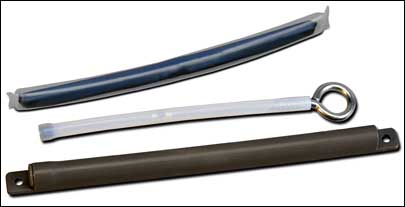William Frick & Co. has partnered with Technologies ROI (TROI), a tag manufacturer based in South Carolina, to develop a passive EPC Gen 2 UHF inlay tag that can withstand temperatures as high as 2,000 degrees Fahrenheit (1,093 degrees Celsius).
Together, the companies have developed a number of different housing options for the tag—known as the SM-HE16—to protect it from exposure to very high levels of heat. According to the company, the tag is now available with four distinct levels of heat resistance, ranging from exposure to 300 degrees Fahrenheit (149 degrees Celsius) to up to 650 degrees Fahrenheit (343 degrees Celsius) for as long as two hours. John Poplawski, William Frick & Co.’s product development manager, says the SM-HE16 with the most heat-robust housing can survive a very brief exposure to 2,000 degrees.
RFID is a technology tool that factories have embraced for many years because it can help quickly and accurately identify parts or tools necessary for a specific production process. The time-intensive process of scanning bar codes or manually reading a part or tool identifier can slow production—especially in environments in which grease or dirt make bar codes or labels impossible to read or scan. Passive tags that operate at low-frequency (125 kHz or 134 kHz) or high-frequency (13.56 MHz) ranges have long been employed in manufacturing applications, because they are less susceptible to RF interference from metallic or liquid sources than ultrahigh-frequency (UHF) passive tags. But William Frick & Co. cites its growing list of manufacturing customers that utilize the company’s heat-resistant UHF Gen 2 passive RFID tags for tracking tools or parts used in harsh production environments, as evidence that this is changing.
William Frick & Co.’s customers are using the heat-resistant tags for industrial applications, including tracking molds or other high-value parts and tools used in such processes as injection molding or painting. Some customers, for instance, employ the tags to track the molds used for injection-molding processes. The molds are portable, and come in different sizes of very small increments, making them nearly indistinguishable from each other.
To differentiate the molds, each has traditionally been etched with a unique tracking number. But dirt and grease often make the etchings very difficult to read, Poplawski says, noting that the SM-HE16 tag provides a faster, more accurate means of identifying the exact molds needed for a particular process. The tags also provide an efficient method for ensuring that the molds are maintained—cleaned, repaired or replaced—on a regular basis. RFID interrogators collect the tag ID of each mold as it is used, and software tracks this usage, generating alerts to staff members whenever a mold is due for a service check, based on the number of times it has been used.
According to Poplawski, William Frick & Co.’s customers have highly specific requirements for the MS-HE16 tags—in the case of injection molds, for instance, a groove is machined into each mold in order to accommodate the tag. But in many cases, he says, the firm also manufactures the MS-HE16 tag in a custom form factor, so that it fits seamlessly into the mold, tool or whatever else a client needs to track. In some cases, the tag contains a built-in eyelet so it can be hung onto a tool or other asset. Other form factors provide holes so the tags can be screwed onto an asset. (Poplawski is not at liberty to discuss any customer applications in detail, due to non-disclosure agreements signed with those clients.)
William Frick & Co. is not the only firm that sells heat-resistant UHF passive Gen 2 RFID tags. However, the company indicates, the high temperature resistance of its SM-HE16 tags makes them stand out in the field.
To ensure that the RFID inlay will survive high levels of heat, TROI sources RFID chips from various suppliers, such as Impinj and Alien Technology. It then solders the chip to an antenna on a small circuit board, which provides the final tags with their first protection to heat damage. Inlays produced for most applications use a conductive glue to attach these two elements, but sustained high temperatures would melt this glue, making the inlay unusable.
The inlays can be embedded in concrete, rubber, fiberglass or other materials, depending on the needs of a particular end user.
While passive UHF tags are more susceptible to RF interference than those operating at lower frequencies, Poplawski says, the durable housing offsets the inlay from metal or liquid in the tag’s vicinity, thereby ensuring adequate read ranges (up to 10 feet of read range in metal-rich environments). What’s more, because the UHF Gen 2 protocol allows greater numbers of tags in close proximity to be read more quickly than those operating at lower frequencies, more tags can be read in less time compared with lower-frequency tags.
William Frick & Co. is demonstrating its MS-HE16 tags and other SmartMark tags in Booth 427 at the RFID Journal LIVE! 2009 conference, being held this week in Orlando, Fla.


